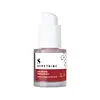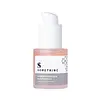What's inside
What's inside
 Key Ingredients
Key Ingredients

 Benefits
Benefits

 Concerns
Concerns

 Ingredients Side-by-side
Ingredients Side-by-side

Triethanolamine
BufferingGlycerin
HumectantLactobionic Acid
BufferingNiacinamide
SmoothingCitric Acid
BufferingGlycolic Acid
BufferingLactic Acid
BufferingPanthenol
Skin ConditioningSalicylic Acid
MaskingPolyglyceryl-4 Caprate
EmulsifyingAmylopectin
Dextrin
AbsorbentHydroxyethylcellulose
Emulsion StabilisingPhenoxyethanol
PreservativeXanthan Gum
EmulsifyingCI 16255
Cosmetic ColorantDisodium EDTA
CI 19140
Cosmetic ColorantCI 17200
Cosmetic ColorantWater
Skin ConditioningWater
Skin ConditioningAcacia Senegal Gum
MaskingPentylene Glycol
Skin ConditioningSalicylic Acid
MaskingTrehalose
HumectantPolyglyceryl-4 Caprate
Emulsifying1,2-Hexanediol
Skin ConditioningButylene Glycol
HumectantBenzotriazolyl Dodecyl P-Cresol
UV AbsorberDisodium EDTA
Hydroxyethylcellulose
Emulsion StabilisingTriethanolamine
BufferingEthylhexylglycerin
Skin ConditioningHydrolyzed Algin
CI 19140
Cosmetic ColorantPhragmites Karka Extract
Skin ConditioningPoria Cocos Extract
Skin ConditioningCI 17200
Cosmetic ColorantPhenoxyethanol
PreservativeZinc Sulfate
AntimicrobialWater, Acacia Senegal Gum, Pentylene Glycol, Salicylic Acid, Trehalose, Polyglyceryl-4 Caprate, 1,2-Hexanediol, Butylene Glycol, Benzotriazolyl Dodecyl P-Cresol, Disodium EDTA, Hydroxyethylcellulose, Triethanolamine, Ethylhexylglycerin, Hydrolyzed Algin, CI 19140, Phragmites Karka Extract, Poria Cocos Extract, CI 17200, Phenoxyethanol, Zinc Sulfate
 Reviews
Reviews

Ingredients Explained
These ingredients are found in both products.
Ingredients higher up in an ingredient list are typically present in a larger amount.
Ci 17200 is a synthetic reddish-purple dye.
CI 19140 is also known as Tartrazine. Tartrazine is a synthetic dye used in cosmetics, foods, and medicine to add a yellow color.
Tartrazine is created from petroleum and is water-soluble.
Some people may experience allergies from this dye, especially asthmatics and those with an aspirin intolerance.
Learn more about CI 19140Disodium EDTA plays a role in making products more stable by aiding other preservatives.
It is a chelating agent, meaning it neutralizes metal ions that may be found in a product.
Disodium EDTA is a salt of edetic acid and is found to be safe in cosmetic ingredients.
Learn more about Disodium EDTAHydroxyethylcellulose is used to improve the texture of products. It is created from a chemical reaction involving ethylene oxide and alkali-cellulose. Cellulose is a sugar found in plant cell walls and help give plants structure.
This ingredient helps stabilize products by preventing ingredients from separating. It can also help thicken the texture of a product.
This ingredient can also be found in pill medicines to help our bodies digest other ingredients.
Learn more about HydroxyethylcellulosePhenoxyethanol is a preservative that has germicide, antimicrobial, and aromatic properties. Studies show that phenoxyethanol can prevent microbial growth. By itself, it has a scent that is similar to that of a rose.
It's often used in formulations along with Caprylyl Glycol to preserve the shelf life of products.
Polyglyceryl-4 Caprate comes from Capric Acid and Polyglycerin-4. It is an emulsifier.
Emulsifiers help stabilize a product. They do this by preventing ingredients from separating, such as oils and water which do not mix naturally.
Salicylic Acid (also known as beta hydroxy acid or BHA) is a well-known ingredient for treating skin that struggles with acne and clogged pores. It exfoliates both the skin's surface and deep within the pores to help clear out buildup, control oil, and reduce inflammation.
Unlike AHAs (alpha hydroxy acids), salicylic acid is oil-soluble. This allows it to penetrate into pores which makes it especially effective for treating blackheads and preventing future breakouts.
Salicylic acid is also known for its soothing properties. It has a similar structure to aspirin and can calm inflamed or irritated skin, making it a good option for acne-prone skin that is also sensitive.
Concentrations of 0.5-2% are recognized by the U.S. FDA as an over-the-counter topical acne product.
It can cause irritation and/or dryness if one's skin already has a compromised moisture barrier, so it's best to focus on repairing that before introducing this ingredient into your routine.
While salicylic acid does not increase sun sensitivity, it’s still important to wear sunscreen daily to protect your skin.
If you are looking for the ingredient called BHA or Butylated Hydroxyanisole, click here.
Learn more about Salicylic AcidTriethanolamine is an emulsifier and pH adjuster. It is created using ethylene oxide and ammonia. This gives Triethanolamine a nitrogen core and a similar scent to ammonia.
As an emulsifier, it prevents ingredients from separating and enhances texture by adding volume to a product.
PH adjusters are common in cosmetic products. The pH of a product can affect the effectiveness of other ingredients. A product with a high pH may also irritate the skin.
Learn more about TriethanolamineWater. It's the most common cosmetic ingredient of all. You'll usually see it at the top of ingredient lists, meaning that it makes up the largest part of the product.
So why is it so popular? Water most often acts as a solvent - this means that it helps dissolve other ingredients into the formulation.
You'll also recognize water as that liquid we all need to stay alive. If you see this, drink a glass of water. Stay hydrated!
Learn more about Water